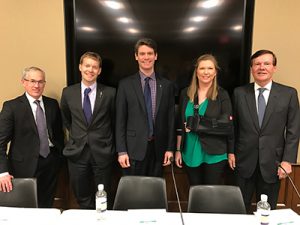
From left: Arthritis 101 briefing panelists Cavan Redmond, Dr. Colin Edgerton, Dr. Angus Worthing, Shannan O’Hara Levi, and briefing moderator Sen. Tim Hutchinson.
On Jan. 31, the ACR partnered with the Arthritis Foundation to host an Arthritis 101 Congressional briefing on Capitol Hill. Panelists educated new and returning members of Congress and their staffers about arthritis and other rheumatic diseases, the cost and impact of rheumatic disease to constituents and the U.S. healthcare system, and current policy challenges and opportunities.
Speaking on behalf of the ACR were Angus Worthing, MD, FACP, FACR, chair of the ACR’s Government Affairs Committee, and Colin C. Edgerton, MD, FACP, RhMSUS, former Army physician and member of the ACR’s Committee on Rheumatologic Care. Other panelists included Shannan O’Hara Levi, a juvenile arthritis patient and Arthritis Foundation advocate, and Cavan Redmond, former CEO of WebMD, pharmaceutical healthcare executive and Arthritis Foundation board member.
The event was co-sponsored by Congressional Arthritis Caucus co-chairs Reps. Anna Eshoo (D-CA) and David McKinley (R-WV) and moderated by former U.S. Senator Tim Hutchinson (R-AR).
The briefing was well attended, with Congressional staffers from both House and Senate leadership present.
“Arthritis is not a Republican or a Democratic disease,” said Rep. Anna Eshoo in opening remarks to the audience. “Chronic diseases bear none of those labels, so it really behooves us to work together.”
Rep. Eshoo went on to highlight the scope of arthritis and other rheumatic diseases, the current specialist shortage and the importance of biomedical research to unlock new treatments and cures. “We need to promote biomedical research so that, one day, we don’t need to have a Congressional Arthritis Caucus,” Rep. Eshoo said. The California Congresswoman closed by encouraging other members of Congress to join the bipartisan Arthritis Caucus.
The Personal Perspective
Ms. O’Hara Levi was the first panelist to speak. “I was diagnosed at age 3 with juvenile rheumatoid arthritis and was told by doctors that I would be in a wheelchair by age 6,” she began. “This is not just an elderly person’s disease.” Ms. O’Hara Levi told the audience that her ability to stand, walk, be a social worker with a rewarding career and have a family were possible only because she had access to specialists and treatments.
The Scope of the Problem
Dr. Worthing spoke next, giving the audience an overview of the ACR and the cost and impact of rheumatic diseases.
“Ensuring quality care for people living with rheumatic diseases has never been more important,” Dr. Worthing stated. “Many people are surprised to learn that rheumatic diseases, including arthritis, are the nation’s leading cause of disability. More than 52 million Americans—one in five people—live with painful, debilitating and life-threatening rheumatic diseases, [such as] arthritis and lupus.”
Dr. Worthing went on to describe the economic toll of these diseases, noting that the CDC estimates rheumatic diseases contribute $128 billion in health costs annually, including $80 billion in annual medical expenditures and $47 billion from indirect costs, such as lost earnings.
“On a more personal level, many of our patients—even those with decent health insurance—have a very difficult time getting affordable care and treatments,” Dr. Worthing said.
“Expensive copays for specialty therapies and frustrating insurance requirements make it hard for many arthritis patients to access timely and effective healthcare. We’re also facing a growing workforce shortage in the rheumatology specialty as many practicing rheumatologists are approaching retirement age and there aren’t enough new doctors completing fellowships in rheumatology to meet the steadily increasing number of arthritis patients in the U.S.,” he said.
“But there is good news,” continued Dr. Worthing. “Early intervention by a trained rheumatologist can greatly improve our patients’ quality of life and significantly reduce long-term costs by helping patients effectively manage pain, slow disease progression and avoid long-term disability.”
“We also have remarkable drugs at our disposal, called biologic therapies. Just a few decades ago, these drugs would have seemed like science fiction. With access to care and treatments like these, many people living with arthritis can lead full and productive lives.”
“But we cannot do it alone,” Dr. Worthing concluded. “We need policies that support a thriving rheumatology workforce, help our patients access the care and treatments they need and that, ultimately, help reduce long-term health costs.”
Impact on the Military
Dr. Edgerton spoke next, discussing the need for a standalone arthritis medical research program within the Department of Defense.
“Arthritis is the leading disease-related cause of discharge from the U.S. Army—second only to injury—and it is a huge cost to the Department of Defense, with very little research looking at ways to prevent it,” Dr. Edgerton began.
Many soldiers are “operating at the level of professional athletes,” Dr. Edgerton explained, which means these service members are especially prone to high-impact injuries that can lead to arthritis. “Imagine carrying more than 100 lbs. of weapons and gear and then jumping into a ditch,” he said. “Maybe something doesn’t feel right, but you grin and bear it and press on. Fifteen to 20 years down the road, you’re looking at a knee replacement at the age of 40.”
Dr. Edgerton stressed that research and prevention efforts within the military system are key to avoid the costly and life-changing injuries that often lead to post-traumatic arthritis. He described the success of a DoD-funded injury prevention lab at Fort Campbell, on the Kentucky-Tennessee border, which integrated physical therapy into basic training programs to give soldiers tools to prevent injury. “That program was highly effective, because there was buy-in from within,” Dr. Edgerton explained.
More information about the impact of arthritis on the military can be found in an op-ed from ACR President Sharad Lakhanpal, MBBS, MD, and Arthritis Foundation CEO Ann Palmer, which was published recently in The Hill. If you are active on Twitter or Facebook, we encourage you to share this piece with your networks as well!
Opportunity for Research
Dr. Edgerton also described the unique research opportunities within the military health system that can benefit the general public, as well as the military population.
“The military health system gives us access to a ‘captive population,’ meaning these individuals are all in the same system and receive their care through the system,” Dr. Edgerton explained.
The military also has a single electronic health records system as well as a serum bank, which allows researchers to go back in time and look for early markers of rheumatic disease.
“Our charge to you is to talk to your bosses about supporting a dedicated arthritis research budget at the DoD,” Dr. Edgerton concluded. “The benefits of such a program will surely touch the lives of your constituents, whether they are in the Armed Forces or not.”
Social Media Engagement
The Arthritis 101 briefing was well received by those online as well. The ACR reached more than 20,100 impressions of live tweets during the event. The Arthritis Foundation and its members were also active on social media during the event and helped share Dr. Worthing’s and Dr. Edgerton’s remarks with their audiences. To see posts from the briefing, visit #AdvocateforArthritis on Twitter and be sure to follow @ACRheum for future policy updates.
If you would like to support the ACR’s advocacy efforts from home, visit the Legislative Advocacy Center to send an email and a tweet to your members of Congress about the need for a dedicated arthritis research budget.
